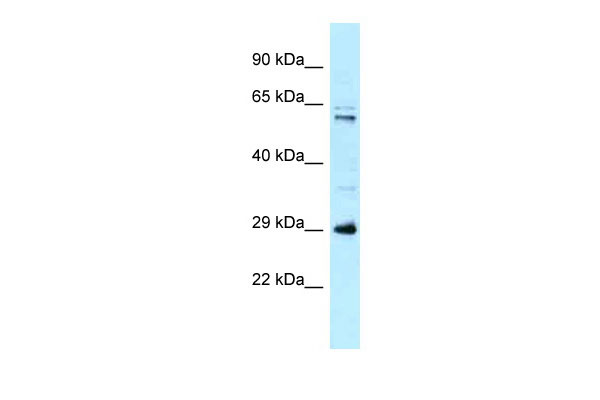HSD17B8 antibody - N-terminal region
Rabbit Polyclonal Antibody
- 产品详情
- 实验流程
Application
| WB |
|---|---|
| Primary Accession | Q92506 |
| Other Accession | NM_014234, NP_055049 |
| Reactivity | Human |
| Predicted | Human |
| Host | Rabbit |
| Clonality | Polyclonal |
| Calculated MW | 26974 Da |
| Gene ID | 7923 |
|---|---|
| Alias Symbol | D6S2245E, FABG, FABGL, H2-KE6, HKE6, KE6, RING2, SDR30C1, dJ1033B10.9 |
| Other Names | Estradiol 17-beta-dehydrogenase 8, 1.1.1.62, 17-beta-hydroxysteroid dehydrogenase 8, 17-beta-HSD 8, 3-oxoacyl-[acyl-carrier-protein] reductase, 1.1.1.-, Protein Ke6, Ke-6, Really interesting new gene 2 protein, Testosterone 17-beta-dehydrogenase 8, 1.1.1.239, HSD17B8, FABGL, HKE6, RING2 |
| Format | Liquid. Purified antibody supplied in 1x PBS buffer with 0.09% (w/v) sodium azide and 2% sucrose. |
| Reconstitution & Storage | Add 50 ul of distilled water. Final anti-HSD17B8 antibody concentration is 1 mg/ml in PBS buffer with 2% sucrose. For longer periods of storage, store at 20°C. Avoid repeat freeze-thaw cycles. |
| Precautions | HSD17B8 antibody - N-terminal region is for research use only and not for use in diagnostic or therapeutic procedures. |
| Name | HSD17B8 |
|---|---|
| Synonyms | FABGL, HKE6, RING2, SDR30C1 |
| Function | Required for the solubility and assembly of the heterotetramer 3-ketoacyl-[acyl carrier protein] (ACP) reductase functional complex (KAR or KAR1) that forms part of the mitochondrial fatty acid synthase (mtFAS). Alpha-subunit of the KAR complex that acts as a scaffold protein required for the stability of carbonyl reductase type-4 (CBR4, beta-subunit of the KAR complex) and for its 3-ketoacyl- ACP reductase activity, thereby participating in mitochondrial fatty acid biosynthesis. Catalyzes the NAD-dependent conversion of (3R)-3- hydroxyacyl-CoA into 3-ketoacyl-CoA (3-oxoacyl-CoA) with no chain length preference; this enzymatic activity is not needed for the KAR function (PubMed:19571038, PubMed:25203508, PubMed:30508570). Prefers (3R)-3-hydroxyacyl-CoA over (3S)-3-hydroxyacyl-CoA and displays enzymatic activity only in the presence of NAD(+) (PubMed:19571038). Cooperates with enoyl-CoA hydratase 1 in mitochondria, together they constitute an alternative route to the auxiliary enzyme pathways for the breakdown of Z-PUFA (cis polyunsaturated fatty acid) enoyl-esters (Probable) (PubMed:30508570). NAD-dependent 17-beta-hydroxysteroid dehydrogenase with highest activity towards estradiol (17beta-estradiol or E2). Has very low activity towards testosterone and dihydrotestosterone (17beta-hydroxy-5alpha-androstan-3-one). Primarily an oxidative enzyme, it can switch to a reductive mode determined in the appropriate physiologic milieu and catalyze the reduction of estrone (E1) to form biologically active 17beta-estradiol (PubMed:17978863). |
| Cellular Location | Mitochondrion matrix |
| Tissue Location | Widely expressed, particularly abundant in prostate, placenta and kidney (PubMed:17978863). Expressed at protein level in various tissues like brain, cerebellum, heart, lung, kidney, ovary, testis, adrenals and prostate (PubMed:30508570) |
Research Areas
For Research Use Only. Not For Use In Diagnostic Procedures.
Application Protocols
Provided below are standard protocols that you may find useful for product applications.
REFERENCES
Kalnine N.,et al.Submitted (MAY-2003) to the EMBL/GenBank/DDBJ databases.
Mungall A.J.,et al.Nature 425:805-811(2003).
Mural R.J.,et al.Submitted (JUL-2005) to the EMBL/GenBank/DDBJ databases.
Ando A.,et al.Genomics 35:600-602(1996).
Ohno S.,et al.Mol. Cell. Biochem. 309:209-215(2008).
终于等到您。ABCEPTA(百远生物)抗体产品。
点击下方“我要评价 ”按钮提交您的反馈信息,您的反馈和评价是我们最宝贵的财富之一,
我们将在1-3个工作日内处理您的反馈信息。
如有疑问,联系:0512-88856768 tech-china@abcepta.com.























 癌症的基本特征包括细胞增殖、血管生成、迁移、凋亡逃避机制和细胞永生等。找到癌症发生过程中这些通路的关键标记物和对应的抗体用于检测至关重要。
癌症的基本特征包括细胞增殖、血管生成、迁移、凋亡逃避机制和细胞永生等。找到癌症发生过程中这些通路的关键标记物和对应的抗体用于检测至关重要。 为您推荐一个泛素化位点预测神器——泛素化分析工具,可以为您的蛋白的泛素化位点作出预测和评分。
为您推荐一个泛素化位点预测神器——泛素化分析工具,可以为您的蛋白的泛素化位点作出预测和评分。 细胞自噬受体图形绘图工具为你的蛋白的细胞受体结合位点作出预测和评分,识别结合到自噬通路中的蛋白是非常重要的,便于让我们理解自噬在正常生理、病理过程中的作用,如发育、细胞分化、神经退化性疾病、压力条件下、感染和癌症。
细胞自噬受体图形绘图工具为你的蛋白的细胞受体结合位点作出预测和评分,识别结合到自噬通路中的蛋白是非常重要的,便于让我们理解自噬在正常生理、病理过程中的作用,如发育、细胞分化、神经退化性疾病、压力条件下、感染和癌症。






